How to Stencil a Wall: A Beginner’s Guide to Allover Wall Stenciling
If you’ve ever wondered how to stencil a wall, don’t miss my beginner’s guide to allover wall stenciling! This step-by-step tutorial will make the stenciling process simple!
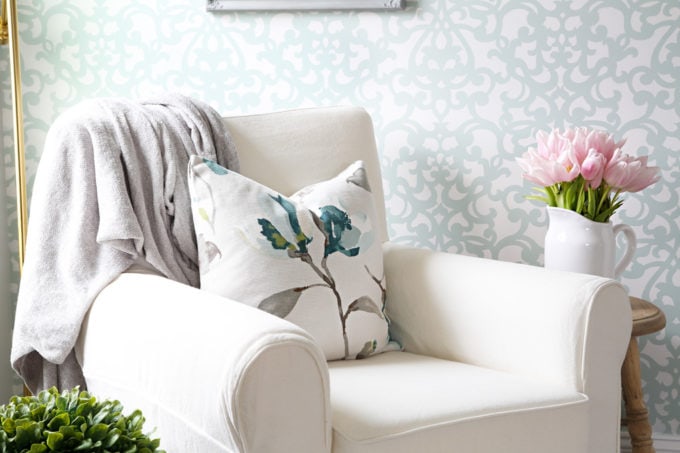
When I started to plan out my home office, I knew I wanted the back wall to make a statement. It will end up being a backdrop for a lot of photos and videos, so I wanted it to stand out. It should be easily recognizable, and of course be absolutely beautiful!
I considered several different ways of achieving this. I could have done some sort of wooden wall treatment like shiplap or board and batten. Or I could have chosen one of the many gorgeous wallpapers that I’ve been seeing pop up all over these days.
But in the end, I found myself coming back to the idea of a stenciled wall again and again. And though I had never stenciled a wall before, I figured it couldn’t be that hard…right? 😉 So I decided to jump right in!
How to Stencil a Wall: Wall Stenciling Step-by-Step Tutorial
This post contains affiliate links. For more information, see my disclosures here.
Time needed: 14 hours
Here are the steps I used to stencil the large back wall in my home office:
- Gather the necessary supplies to stencil a wall.
The supplies I used for my project are as follows:
Wall Stencil (I used the Donatella Damask Stencil for my project.)
Level
Pencil
Paint (I used Behr Marquee Cameo White and Sherwin Williams Rainwashed, color matched in Behr Marquee paint.)
Painter’s tape
Mini foam roller
Paint tray
Paper towels
Stencil brush
Small paint brush
Scissors (optional) - Paint the base color on the wall.
Next I had to decide on colors. I already knew that I wanted to do white + the aqua color that I had already painted my office nook, but I had to choose which one would be the base color and which color I would stencil over top.
As I looked at different examples of stenciled walls, I realized that with the stencil pattern I had chosen, if I did the white as my base and the aqua color on top, I would have a more bold wall. And if I did an aqua base with a white stencil over it, my design would be a little more muted. Since I tend to be a bit scared of bold pattern, I decided to go with the latter combination.
The exact colors I used were Behr Marquee Cameo White and Sherwin Williams Rainwashed. (But I had Rainwashed color matched in the Behr Marquee paint since it is my favorite!)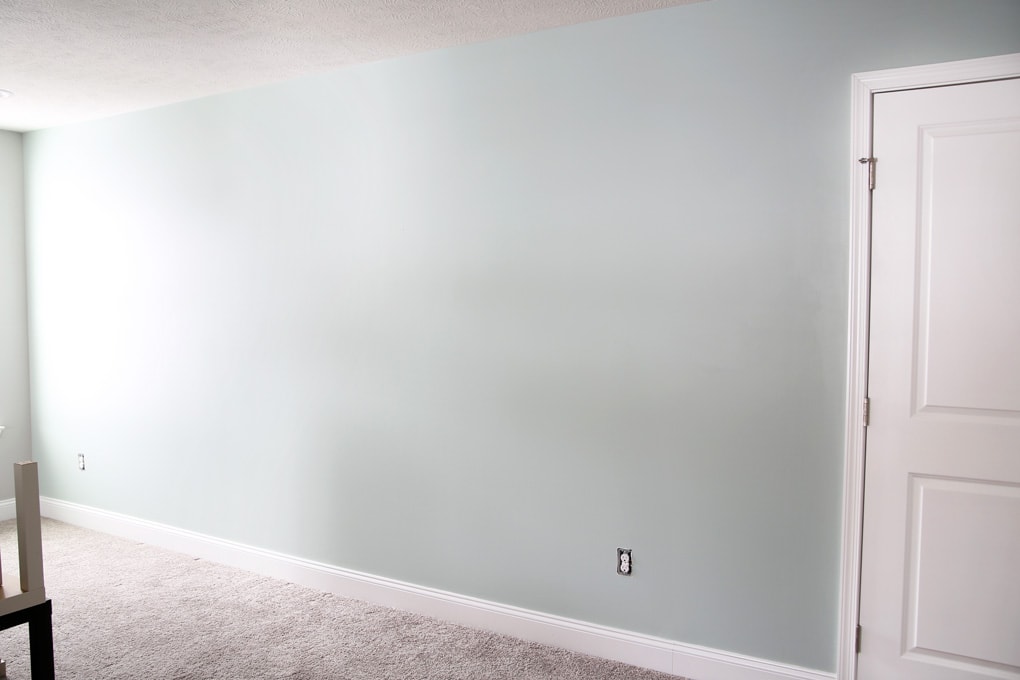
- Draw a straight line down the middle of the wall to align the stencil.
To make sure that my stencil pattern would be completely straight, Donnie helped me draw a perfectly straight vertical line down the middle of the wall with a pencil.
That way I could set my first row of stenciling right against that line. Then all of the rest of my rows would be built upon that one, ensuring that they would all be straight.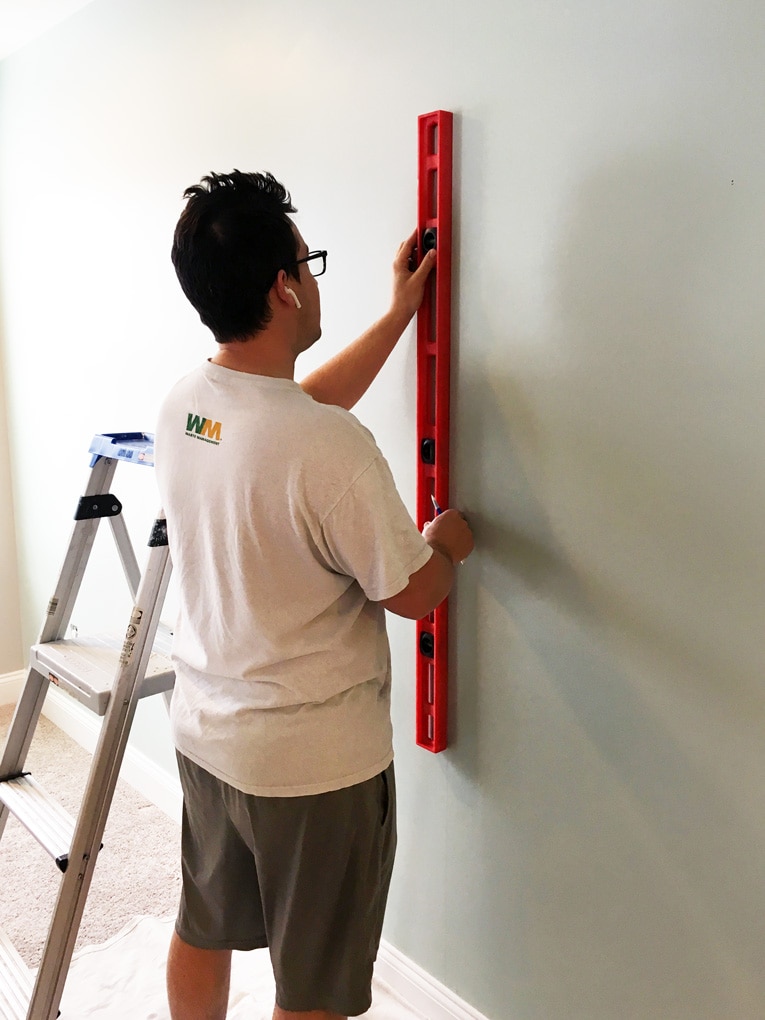
- Tape the stencil to the wall.
To place the stencil the very first time, I lined it up with the pencil line that Donnie had drawn. I also placed it right up against the ceiling.
My stencil set came with a coordinating ceiling stencil. So if I started my design at ceiling level, I would be able to go back in with the smaller stencil later and easily fill in the little gap at the top. (You’ll see what I mean in a minute!)
I just used painter’s tape to adhere my stencil to the wall. Some of the instructions and tutorials I read recommended using a spray adhesive on the back of the stencil as well. But that sounded messy to me, so I used tape by itself. I didn’t have any trouble.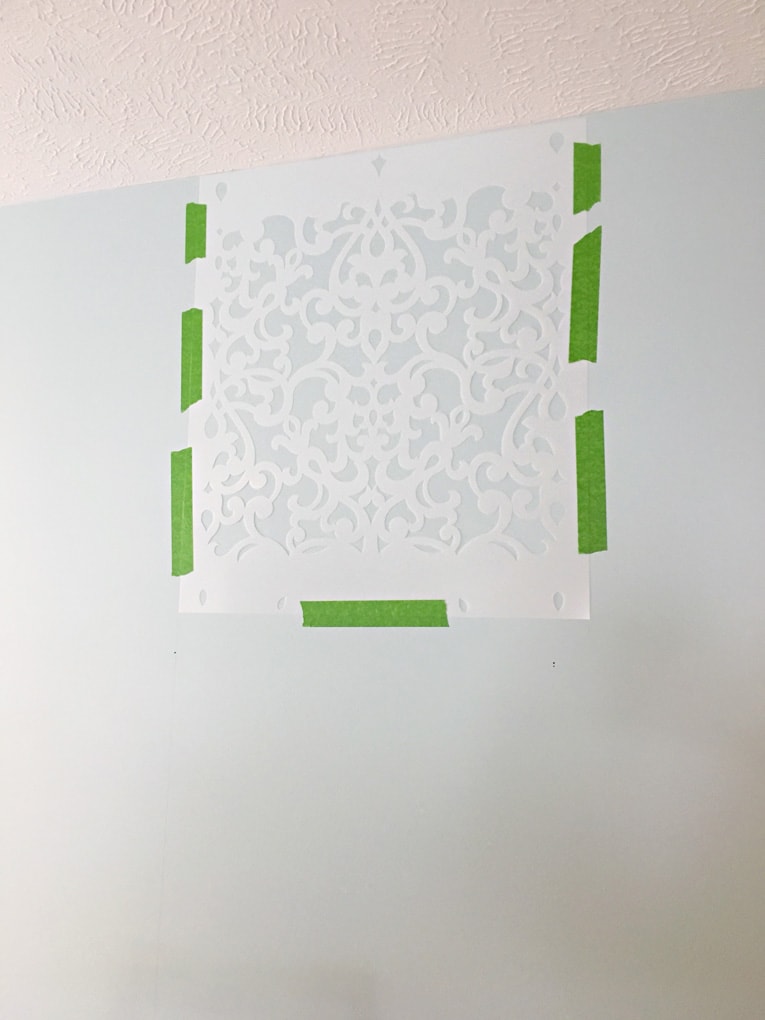
- Begin rolling the paint over the stencil on the wall.
I think one of the biggest keys to getting a nice, clean stencil line is to use very, very little paint. I opted to use a mini foam roller to apply most of the paint.
So I would load my roller and roll off some of the paint in my paint tray. Then I’d do a roll or two on a paper towel. This would ensure I had only a very thin layer of paint on my roller.
I would then roll a coat of paint over my stencil. Often, since there was so little paint on my roller, I would have to refill my roller 2-3 times and go over the stencil again to make sure it was completely filled in.
I found that doing several of these thin coats one right over the other worked well. It really minimized bleeding under the stencil.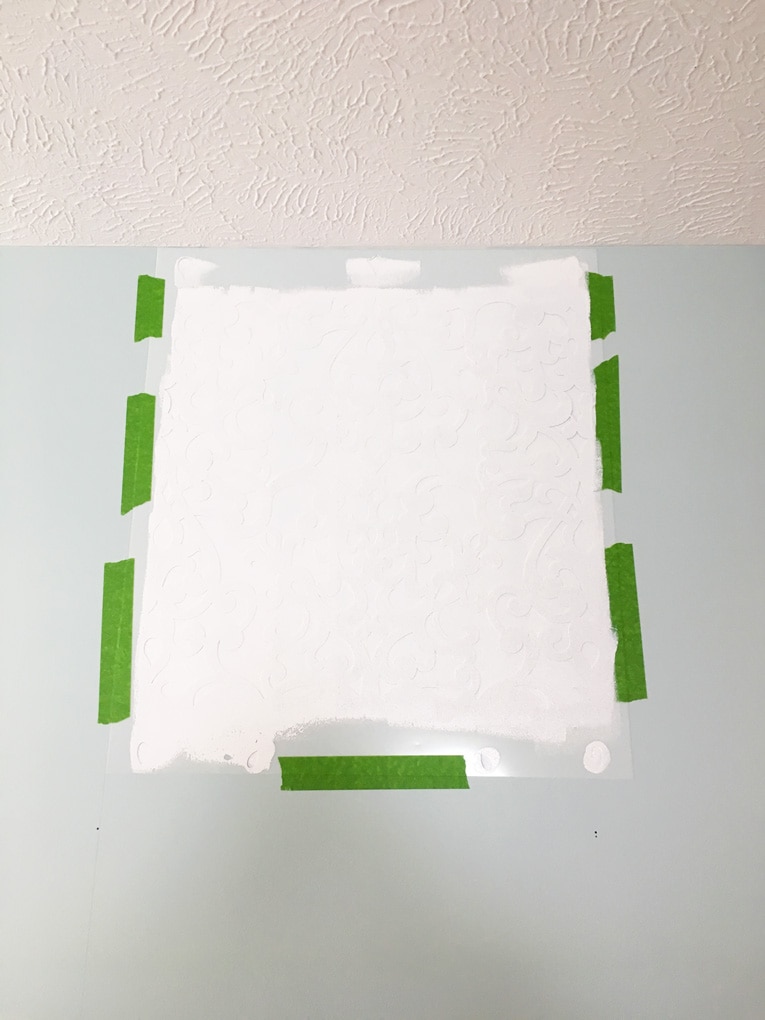
- Use the registration marks to line up the stencil and continue the pattern on the wall.
At the top, bottom, and side edges of the stencil, there are registration marks that help make sure that the stencil is lined up in the correct position. I would typically finish rolling my paint and remove the stencil right away.
Then I’d let the paint dry for a minute or two and use the registration marks to position the stencil again.
Since I was using very thin coats of paint, they dried quickly. I didn’t have to wait long in between stencils.
I also staggered the placement of the stencil, which allowed me to go more quickly. So, for example, while the paint for the stencil in the below photo was drying, I would remove the stencil and place it beside the top row. I’d roll the paint over that one, and then by the time I was finished there, I could move the stencil back down to the bottom. By then, the first stencil I had done was dry and ready to go.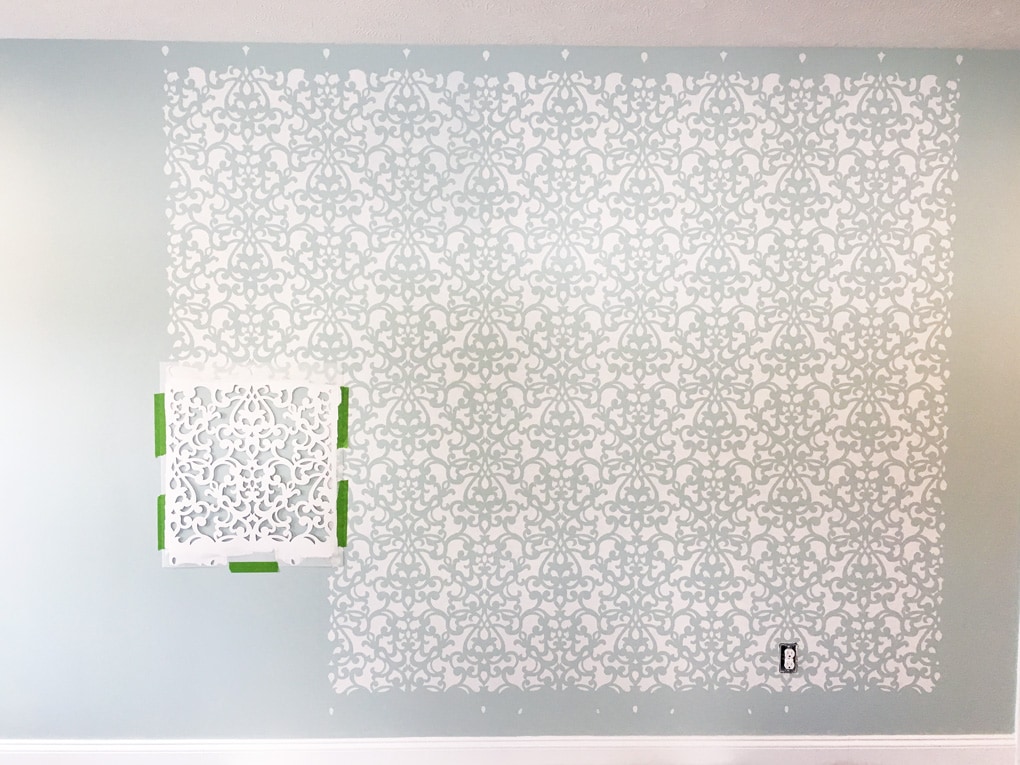
- Use the ceiling stencil to fill in the top of the design.
The main part of the wall was a little time consuming, but the process was pretty straightforward– tape the stencil, paint, move the stencil, paint again, repeat. Eventually, though, that easier section was done, and it was time to tackle the edges.
As I mentioned previously, my stencil came with a smaller piece that was designed to help fill in the gap along the ceiling line. I actually ended up trimming down the top of the ceiling stencil by about 1/4″ or so. This allowed me to place it right up against the ceiling rather than it rolling up onto the ceiling, which would make it harder to stencil.
- Use a stencil brush or paint brush for smaller details if necessary.
For the smaller pieces like the ceiling and the edges, I used a stencil brush like the one below rather than a roller because it was easier to manipulate in the smaller spaces.
If there was a spot that was really teeny tiny, I kept a small paintbrush handy and used that to fill in when necessary.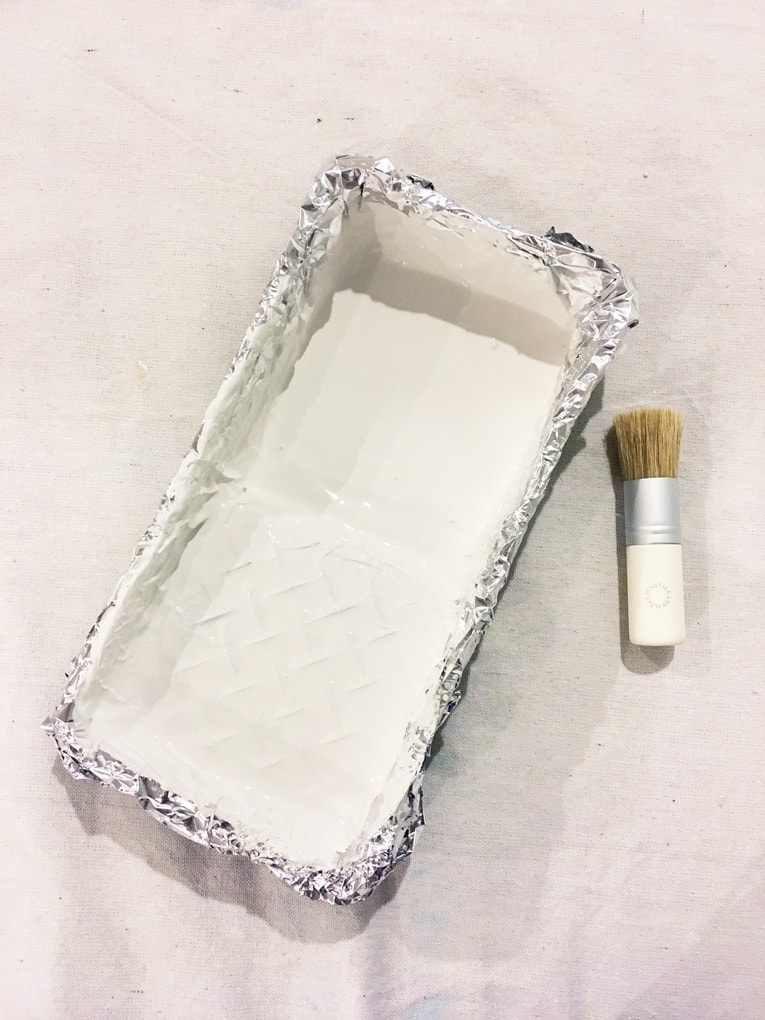
- Fill in the edges of the wall with a stenciled pattern.
My stencil didn’t end up hitting the edges of my wall exactly. I had to do a bit of maneuvering to stencil each end and the very bottom of my wall.
I would first tape the edge of the opposite wall where I didn’t want the paint to seep. Then I would just let the stencil bend into the corner and press it in with my fingers on one hand and stencil with the other hand.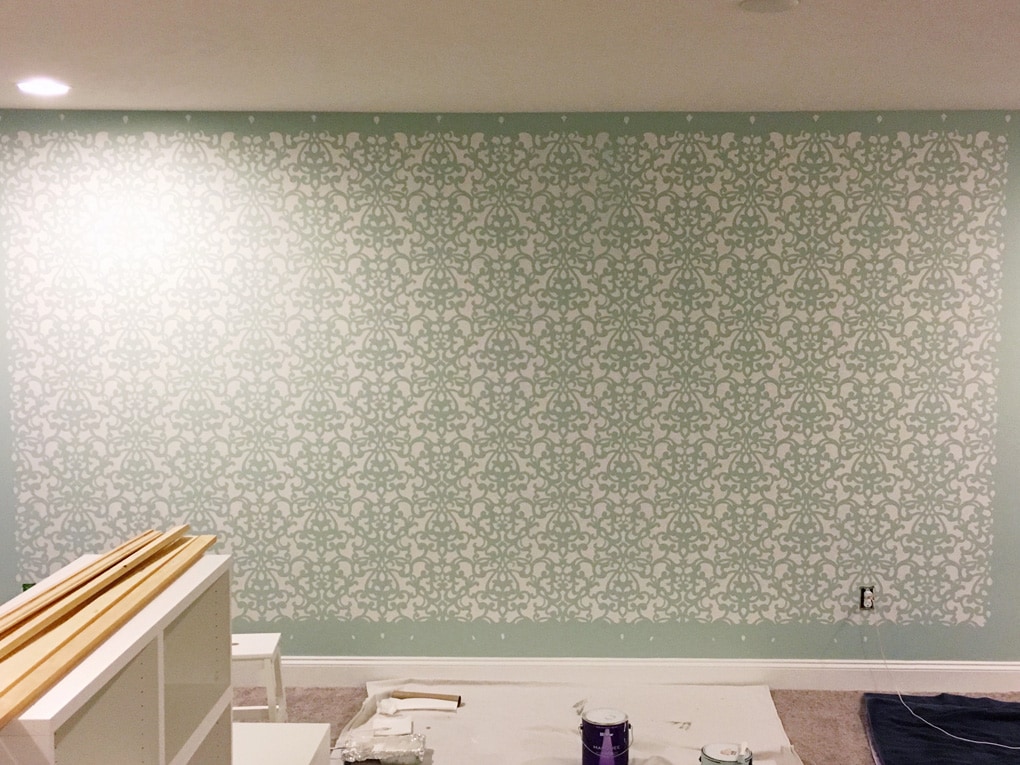
- . How to Deal with Tricky Pieces of Wall When Stenciling
The one piece of the wall that perplexed me a bit was a little two-inch strip between the door molding and the wall. There was no way to bend the stencil to make it fit neatly in that space. So I ended up cutting a two-inch strip out of my stencil once the rest of the wall was complete and using that to fill in the gap.
(If you were planning on using your stencil somewhere else and didn’t want to cut it, one of my Instagram friends suggested making a photocopy of the stencil and cutting that, perhaps out of cardstock, which I thought was a great idea!)
As you can see, I taped up both the door frame and the wall so I wouldn’t get paint on them, then taped my little piece of stencil into the gap, and just filled in with paint like I had on the other edges.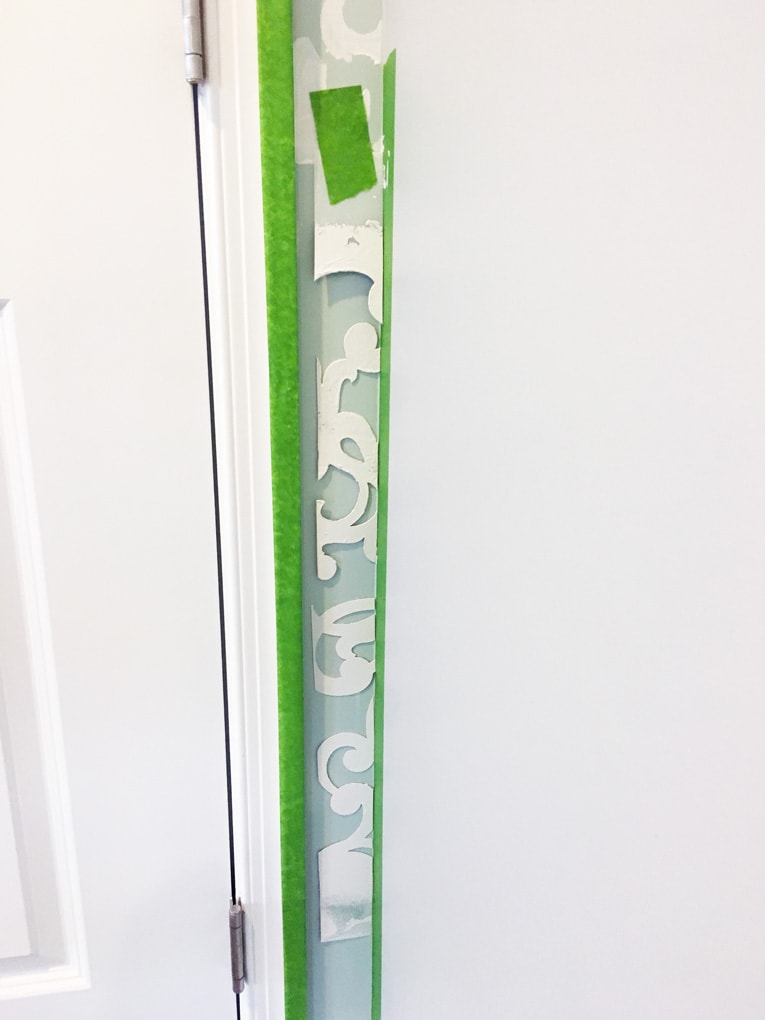
- . Enjoy your newly stenciled wall!
I pulled the tape away, and my wall was done! Yippee!
I did go in and end up touching up a few spots with paint where the lines weren’t totally crisp. It still is not 100% perfect, but the pattern is pretty forgiving, so I didn’t have to be too nit-picky with it.
I would say all in all I spent about 14 total hours stenciling. (And I tend to be kind of slow because I’m a perfectionist, so other people would probably be faster than me!)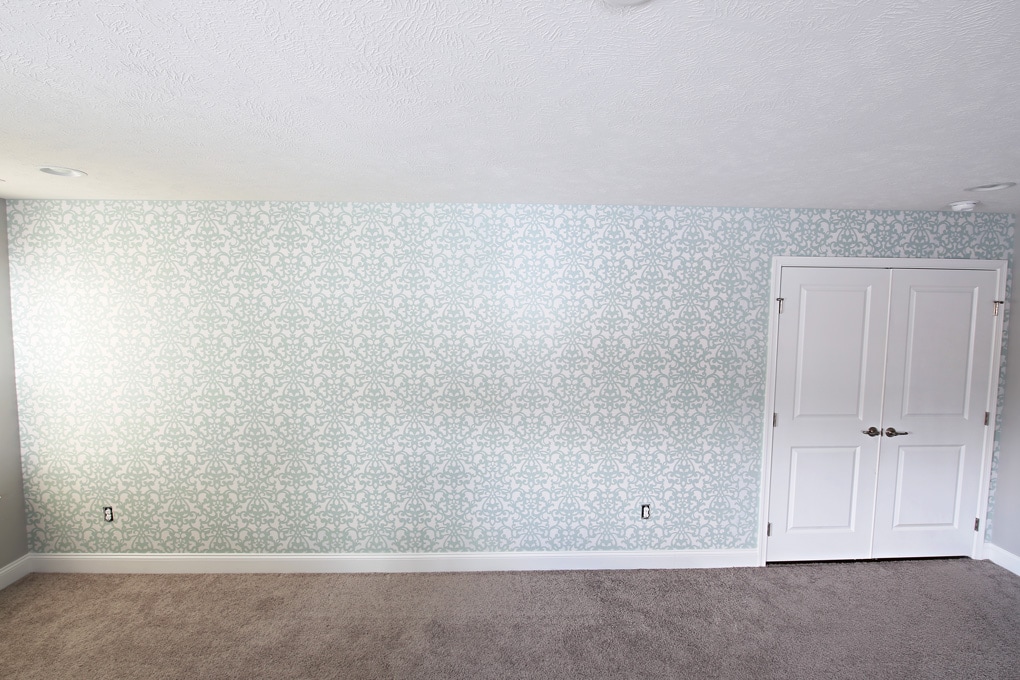
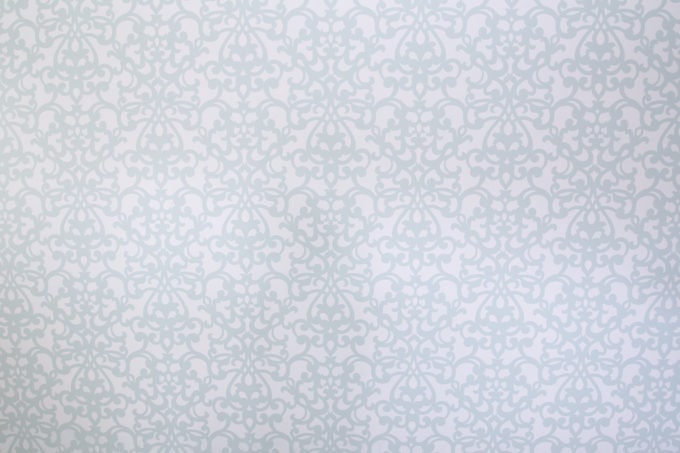
I think the stencil achieved my goal of having a wall with “wow” factor! It definitely makes a statement in the room, and I love how it turned out!
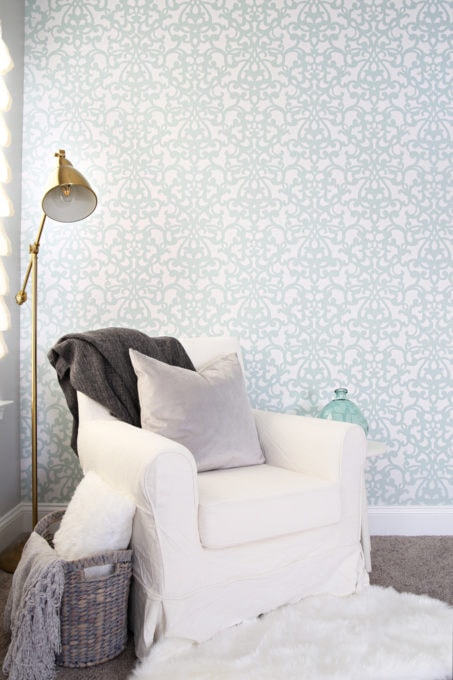
I am excited to share a few more projects we’ve been working on in this space and, of course, the final reveal of the entire office soon, so stay tuned!! (Update: The office is done! See it here!)

How to Stencil a Wall: Frequently Asked Questions
Have you ever stenciled a wall? I’d love for you to add your best tips in the comments!
Have a wonderful day!

This post contains affiliate links. For more information, see my disclosures here.

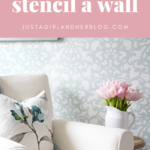
Abby, I like the end result! I wonder what you do beside the door frame if you want to use the stencil again. So great timing! I just purchased an overall stencil for one accent wall. I see your walls/ceilings appear to be somewhat level? Did you have to adjust anywhere to give the appearance of level? Very nice job!
Thank you so much for your sweet words, Linda! Our ceiling was just slightly not level, so I did go by the vertical line that we drew at the beginning, rather than the ceiling. The stencil is pretty forgiving, though, and since it was only off slightly, I really didn’t have to compensate for it. Have fun with your accent wall– I’m sure it will be beautiful!
~Abby =)
This is definitely a wow factor, Abby! Great job on all your hard work.
Thanks so much, Micah! I am LOVING it! Happy Friday! <3
~Abby =)
Wow, it’s beautiful! Your effort definitely worked out. Xxx Marijke
Thanks so much, Marijke! Have a great weekend! <3
~Abby =)
This looks absolutely stunning and a lot easier to do than I thought! It definitely has the wow factor and makes a great alternative to wallpapering. I can’t wait to come up with a design and give it a go. Thanks so much for the inspiration!
Holly from The Art of Being Holly xo
So glad it was helpful, Holly! It really was much easier than I was expecting! Have fun! 🙂
~Abby =)
You did a great job! It is probably delightful to look at. Thank you — you have given the rest of us perfectionists hope! 🙂
Lol! Thank you so much for your sweet words, Dianne! I hope you’re having a wonderful weekend!
~Abby =)
I love this SO much!!! Beautiful!!! ?
You are the sweetest! Thank you so much, Olivia!
~Abby =)
The wall looks stunning! One question: did you use the ceiling stencil to finish the bottom of the wall as well? It seems to be a larger strip than the one at the ceiling.
Hi, Kathy! I did the bottom the same way as the corners. So I taped off the baseboard, and then just lined up the regular stencil, which ended up overlapping the baseboard. At the spot where the wall meets the baseboard, I just kind of pushed in the stencil with my fingers and used the smaller brushes to fill it in. I hope this helps!
~Abby =)
this looks great abby!! i did stenciled borders all around the top of 2 of my kids rooms – about 30 years ago! i can’t imagine doing a whole wall!!?! these days i’m dreaming of painting calligraphy on a wall! maybe i’ll have to challenge my patience again at some point and do it! i’ve also done it on canvas – flat paint and with also with texture – lots of fun! again – this looks so pretty!!
Ooo, sounds like fun! I’m sure your calligraphy will be beautiful! Have a great week, Tetia! <3
~Abby =)
Gorgeous! Super nice! Good thinking about the color choices. It’s very elegant and will be a great backdrop for photos. Congrats!
I would not have thought of stenciling a whole wall like that. I’ll have to take a look at some other stenciling projects just to see what’s being done now.
You had great determination to finish that project! I doubt I could see it all the way through, and that would keep me from even starting… makes me wonder if it would be faster using a larger stencil, twice the size, or two of them — maybe that would bleed too much — maybe it would need the spray adhesive or tape on the back to keep the middle edges in contact with the wall.
BTW, you can buy the plastic for stencils and cut with an X-acto knife yourself, in whatever pattern you draw. A friend sent me some decades ago and told me I should stencil. But the examples were all borders — not any whole walls like yours. Somewhere I have that plastic. Not sure what “mil” thickness it is but to me, it’s just a stiff plastic like the thin cutting mats one can buy for kitchen counters.
Thanks so much for the tip! Hope you’re having a great Monday! <3
~Abby =)
Wondering where you got your wall stencil? I love your wall it turned out Great!
Hi, Amy! I got it from Royal Design Studio. I linked to the exact stencil in Step 1 of the post! Thanks and have a great day! <3
~Abby =)
Wow! It turned out beautifully, Abby! Thanks for sharing!
Thanks so much, Jennifer! Thanks for stopping by! <3
~Abby =)
That looks beautiful!! I love the subtle design and the colors you used.
Aw, thanks so much, Amanda! Hope you’re having a great Monday! <3
~Abby =)